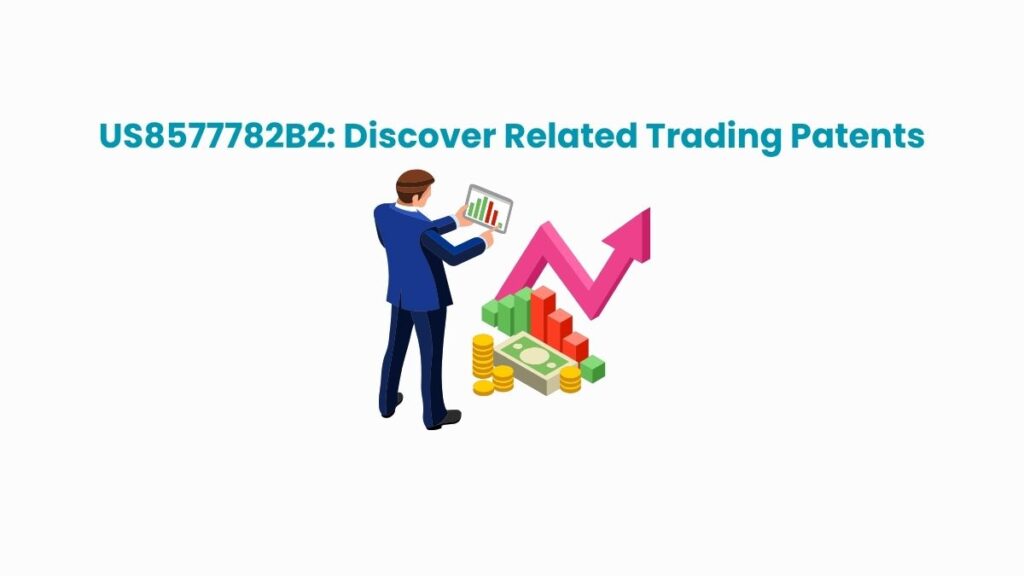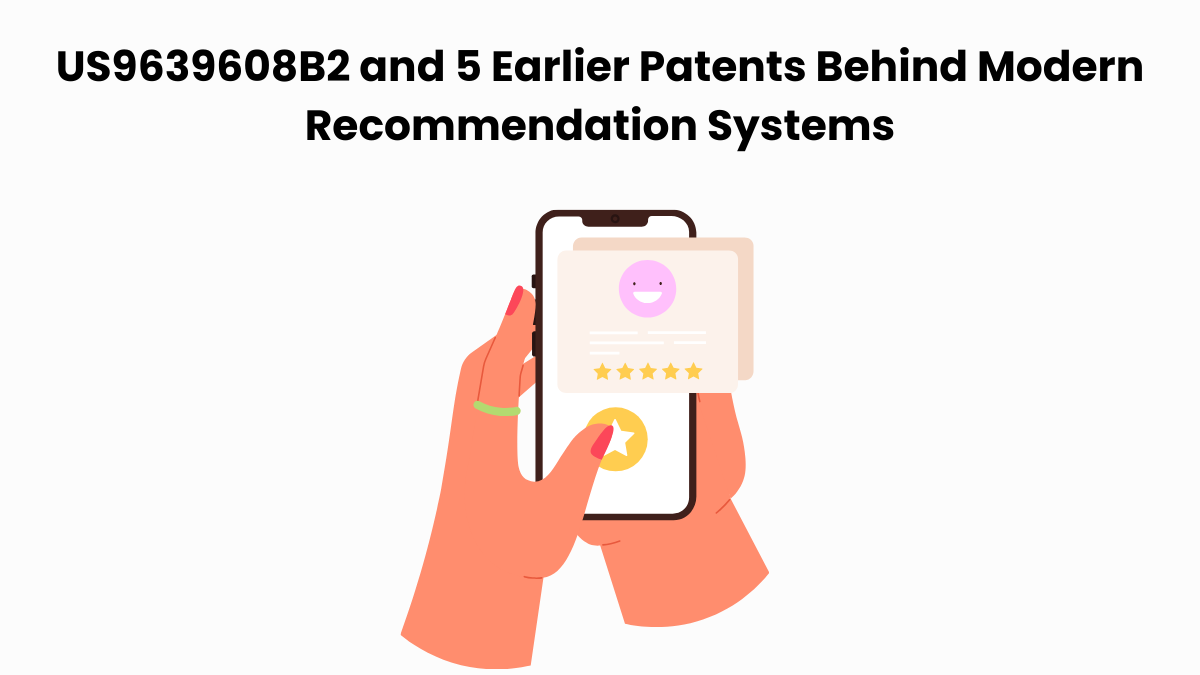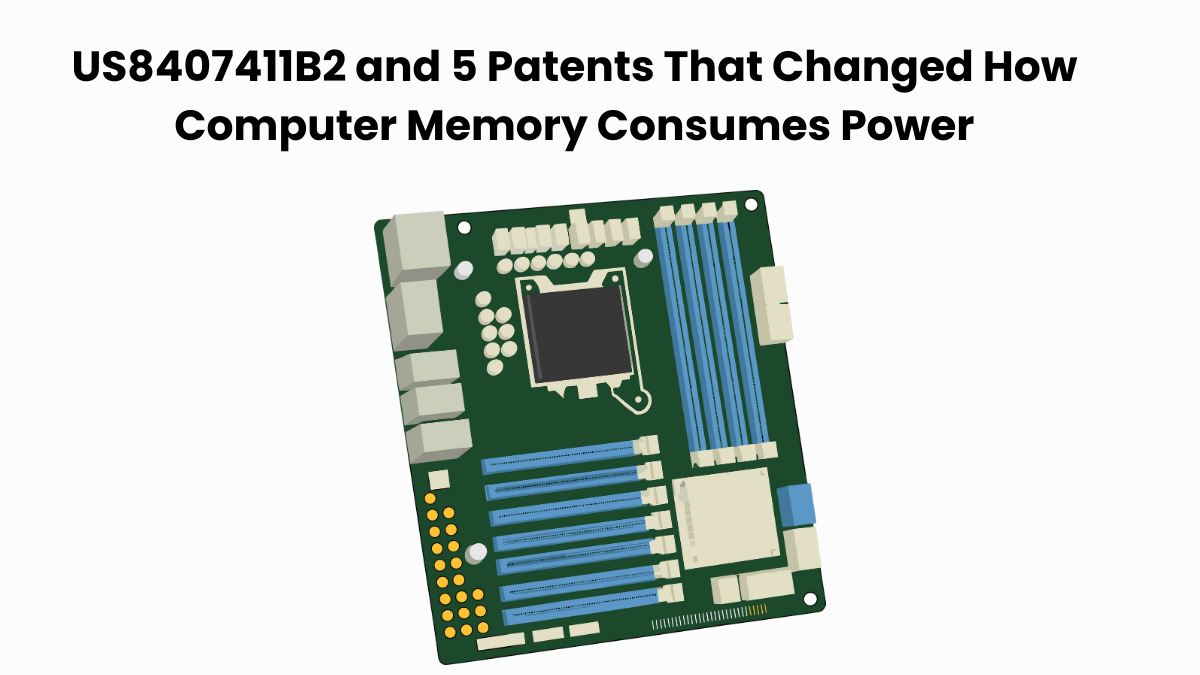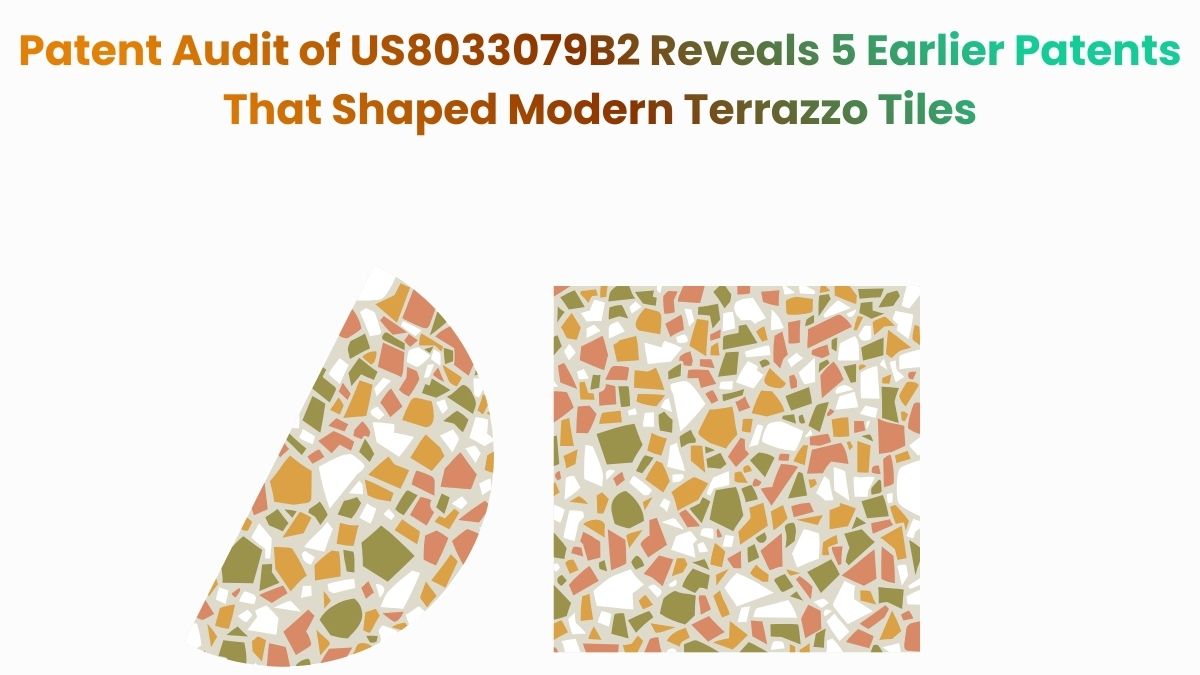Some patents quietly underlie the frameworks of digital marketplaces. Others come into the spotlight because of their core concepts that are increasingly central to modern trading platforms. Patent US8577782B2 clearly belongs to the latter category. As seen in many embedded finance platforms, behavioral data and transaction histories are becoming core to offer personalization and market liquidity.
Cedar Lane Technologies, a non-practicing entity (NPE), has filed multiple suits involving this patent against companies including Cobra Trading, Doo Technology, FMR LLC, and The Charles Schwab Corporation.
While this article doesn’t focus on litigation, understanding the patented technology is essential. This patent is about a method for generating conditional offers tailored to semi-anonymous trading participants, based on their trade history and unique identifier.
In this article, we’ll use the Global Patent Search (GPS) platform to explore patents that share conceptual or structural similarity with US8577782B2. This GPS-driven investigation offers a clear, data-driven perspective on how these concepts align with the evolving landscape of conditional trading mechanisms.
Understanding Patent US8577782B2
Patent US8577782B2 introduces a trading system that delivers customized, conditional offers to semi-anonymous market participants. It leverages unique identifiers and transaction history to tailor pricing strategies for individual trading entities.
The invention creates a dynamic framework where liquidity providers can analyze behavioral patterns without needing to know a participant’s true identity. This system enables more efficient trading, pricing accuracy, and the ability to mitigate risk from high-frequency or “toxic” traders.
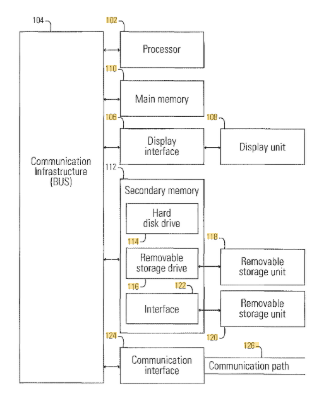
Source: Google Patents
Its four key features are
#1. Trade history-based profiling: Analyzes a trading entity’s past transactions to build behavioral profiles used in offer generation.
#2. Identifier-driven anonymity: Uses profile identifiers to preserve semi-anonymity while still linking behavior across transactions.
#3. Targeted conditional offers: Generates distinct trade offers for different participants, based on real-time and historical data analysis.
#4. Exchange integration: Interfaces with electronic exchanges to match personalized offers with appropriate trading entities.
This patent defines a data-driven framework for customizing liquidity offers within electronic marketplaces. Its architecture supports more intelligent price setting while balancing privacy and predictive analytics in trading environments.
Similar Patents As US8577782B2
To explore the innovation landscape surrounding US8577782B2, we analyzed it using the Global Patent Search tool. Below is a quick glimpse of the GPS tool in working:
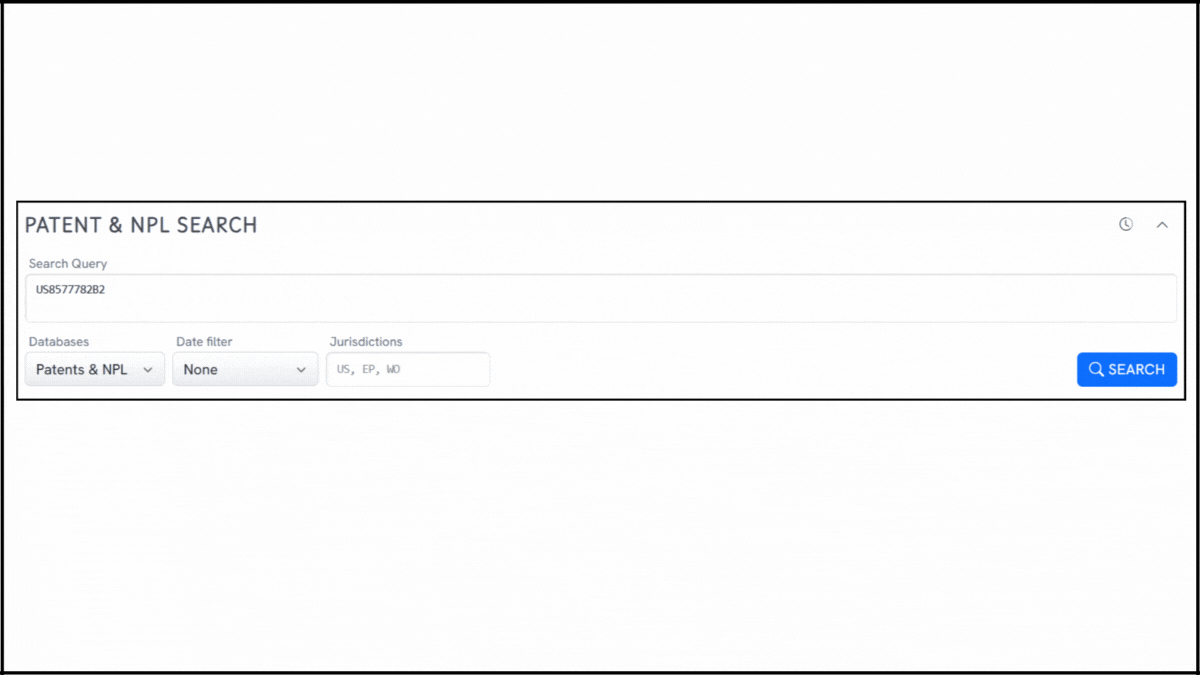
Source: Global Patent Search
This surfaced a collection of patents with overlapping themes in trading intelligence, participant profiling, and targeted offer execution. Below are such examples that showcase how conditional and behavior-based trading architectures have evolved over time:
#1. US20020010672A1
This US patent US20020010672A1, published in 2002, outlines a system for managing certified trading interests (CTIs) through participant behavior analysis. It leverages confidential trading history to tailor execution strategies, enabling targeted interactions and secure trade matching.
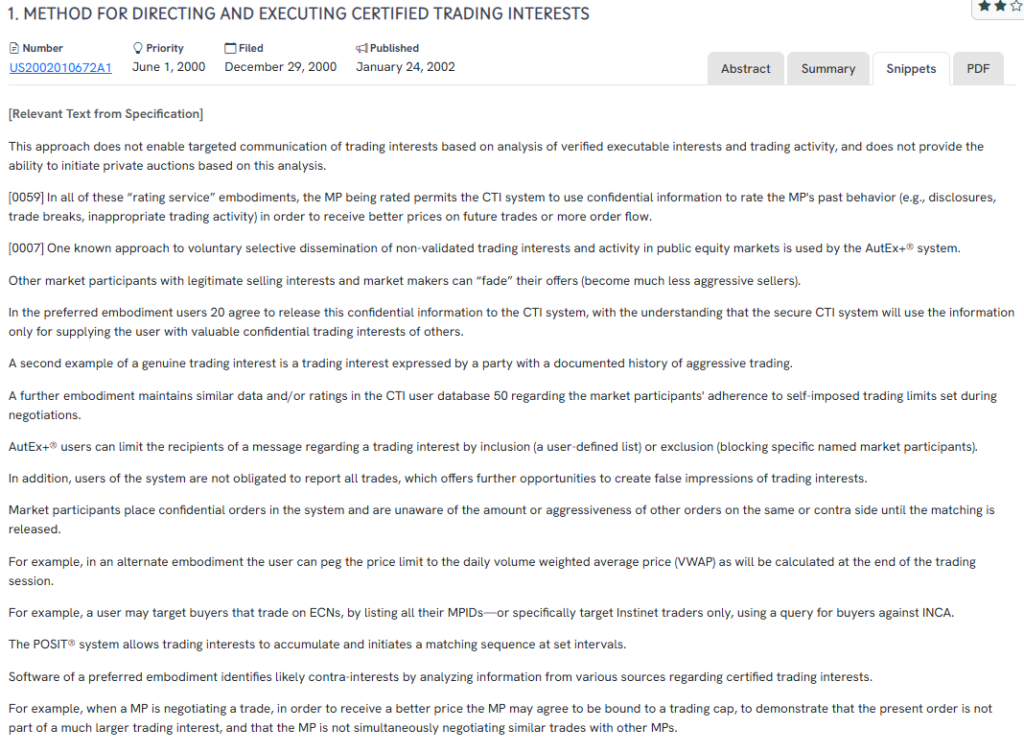
Source: GPS
What this patent introduces to the landscape?
- Participant behavior scoring: Rates market participants using confidential past activity, including trade breaks and negotiation conduct.
- Targeted trading offers: Allows controlled sharing of trading interests with selected parties based on profile criteria.
- Private trading auctions: Supports secure auctions initiated by behavioral triggers and past trade validation.
- Historical trading validation: Encourages traders to share verified activity to receive better pricing or exclusive opportunities.
How it connects to US8577782B2?
US8577782B2 similarly generates offers based on a trading entity’s profile, built from historical activity linked to semi-anonymous identifiers. Both patents:
- Rely on behavior-driven profiling
- Enable conditional access to trading opportunities
- Emphasize confidentiality and selective data exposure
Why this matters?
US20020010672A1 reflects early adoption of data-informed trading strategies. It helps contextualize US8577782B2 within a broader evolution toward systems that combine anonymity with predictive intelligence for tailored market interactions.
We also covered the optical motion-sensing approach of US7400950B2, where aircraft use ground-facing image displacement to calculate movement and maintain stable hovering, a complementary method to the sensor logic discussed here.
#2. US6985883B1
This US patent US6985883B1, published in 2006, introduces a system for managing credit constraints in anonymous electronic trading environments. It focuses on filtering executable trades based on confidential credit thresholds while preserving participant anonymity.

Source: GPS
What this patent introduces to the landscape?
- Anonymity with constraint validation: Maintains counterparty anonymity while enforcing predefined credit restrictions during trade matching.
- Credit-aware trade filtering: Automatically blocks trades that exceed credit limits, ensuring financial eligibility before execution.
- Eligibility-based matching: Only counterparties with mutual credit compatibility are shown as valid trading options.
- Confidential credit data: Sensitive credit terms are used internally without disclosure, protecting each participant’s trading thresholds.
How it connects to US8577782B2?
Both patents emphasize semi-anonymous trading interactions controlled by profile-based data. While US8577782B2 uses trading history for profiling, US6985883B1 applies credit thresholds. Their shared architecture includes:
- Anonymous participant matching
- Condition-based filtering for transaction eligibility
- Use of private participant-specific parameters
Why this matters?
US6985883B1 showcases how trading systems can enforce participant-specific constraints while preserving anonymity. It complements US8577782B2’s goal of individualized, profile-informed trading, highlighting early innovations in customizing trade permissions based on non-public metrics.
For teams exploring software portability, our article on US7774762B2 explains how a capsule runtime intercepts and filters system services so legacy applications can operate on incompatible platforms.
#3. US20020116317A1
This US patent US20020116317A1, published in 2002, presents a system for conducting reverse auctions of financial instruments with flexible, credit-aware trading rules. It allows for customized credit screening and anonymous bid submission, enabling smarter counterparty selection.
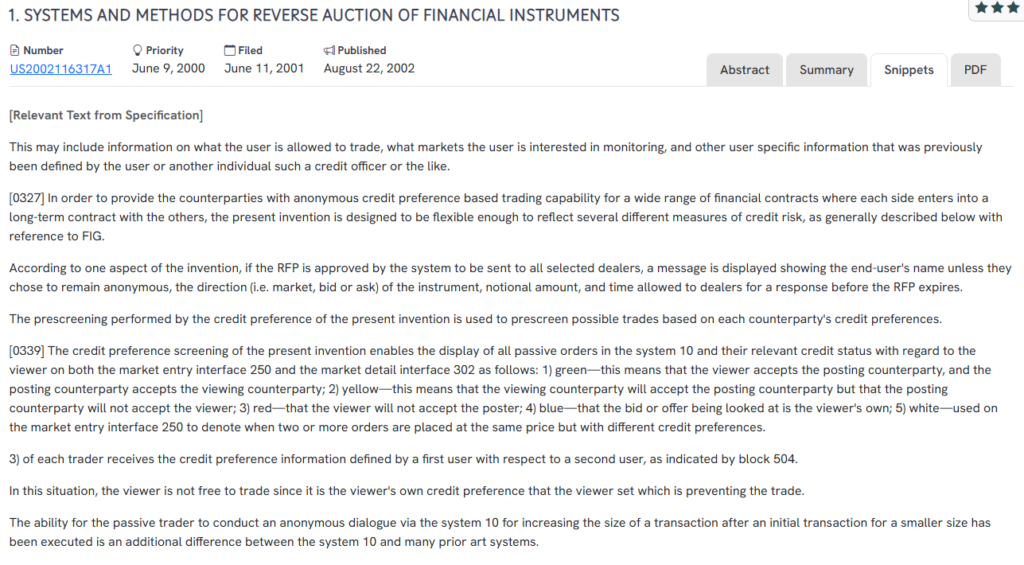
Source: GPS
What this patent introduces to the landscape?
- Credit preference filtering: Screens potential trades based on each counterparty’s predefined credit preferences before initiating a transaction.
- Anonymous reverse auction: Supports anonymous participation while revealing selective details like bid/ask direction and notional amounts.
- Flexible credit modeling: Allows diverse credit risk measures to be used in real-time trading decisions.
- Dynamic counterparty interface: Displays trade eligibility with visual status indicators, enabling users to see real-time trade compatibility.
How it connects to US8577782B2?
US8577782B2 and US20020116317A1 both enable conditional trading based on user-specific parameters. While one uses trade history profiles, the other applies credit preferences. Common themes include:
- Customized trading filters
- Anonymity in trading interactions
- Participant-specific access control
Why this matters?
US20020116317A1 highlights the role of tailored filters in anonymous trading. Like US8577782B2, it shows how trading platforms evolve to accommodate conditional access: bridging flexibility, privacy, and targeted execution logic.
#4. US20140136386A1
This US patent US20140136386A, published in 2014, outlines a conditional trading system where liquidity providers generate personalized offers based on semi-anonymous participant profiles. It builds a profile-driven architecture for targeted market interactions.
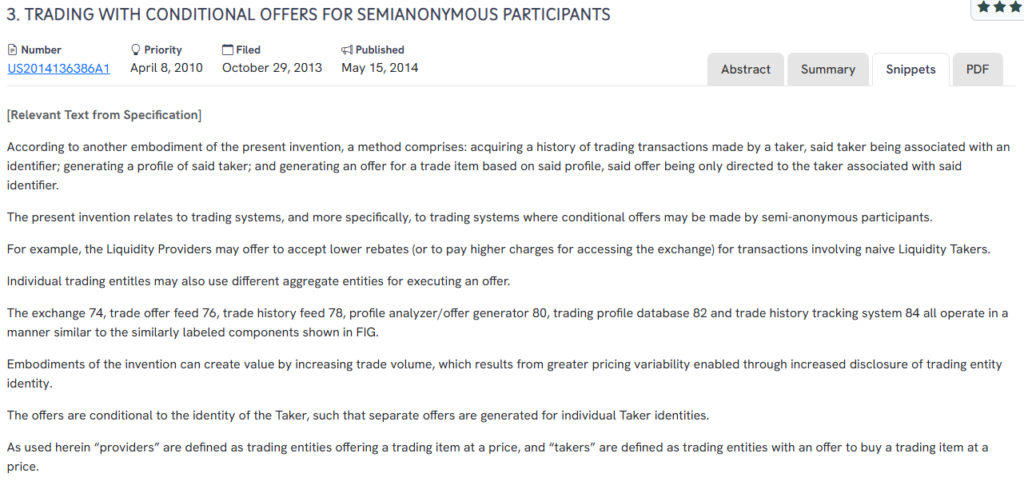
Source: GPS
What this patent introduces to the landscape?
- Profile-based offer generation: Creates trade offers tailored to takers using transaction histories tied to unique identifiers.
- Semi-anonymous matching logic: Preserves participant privacy while enabling differentiated pricing per user profile.
- Behavior-driven pricing strategy: Offers vary based on taker behavior, enabling liquidity providers to adapt pricing dynamically.
- Exchange-integrated architecture: Features modules for offer feeds, trade tracking, and historical data analysis tied to identifiers.
How it connects to US8577782B2?
US20140136386A1 is a direct relative of US8577782B2. Both share nearly identical mechanisms:
- Identifier-based profiling
- History-driven trade personalization
- Conditional offers based on taker behavior
- Integrated exchange infrastructure
Why this matters?
This reference shows continuity and iteration within the same technical family. It reinforces the concepts at the core of US8577782B2, especially semi-anonymous trading and profile-informed offer generation, underlining their significance in shaping targeted market systems.
If you’re interested in how hardware tokens interact with broader systems, see our stress test of US9450956B1 and its related proximity access innovations.
#5. US20050234805A1
This US patent US20050234805A1, published in 2005, introduces a system for anonymous, multiparty negotiation in fungible asset markets. It adds dynamic incentive mechanisms to sustain engagement and facilitate price discovery through ongoing private negotiations.
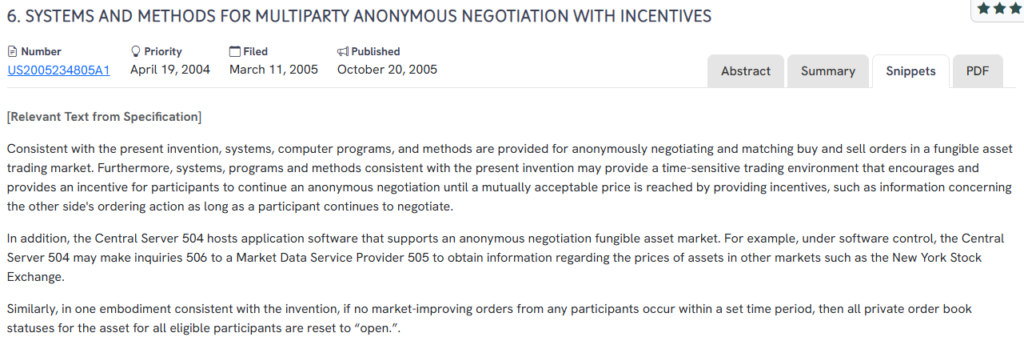
Source: GPS
What this patent introduces to the landscape?
- Anonymous negotiation environment: Buyers and sellers remain unidentified while negotiating toward a mutually acceptable trade price.
- Incentive-based participation: Offers trading incentives, such as additional market data, to participants who actively stay engaged in negotiation.
- Time-sensitive trade resets: If market activity stalls, order books are reset to encourage renewed negotiation among all parties.
- External price data integration: Pulls asset prices from third-party markets to inform negotiation context and enhance decision-making.
How it connects to US8577782B2?
While US8577782B2 targets conditional offer generation using trade profiles, US20050234805A1 focuses on maintaining engagement through anonymous negotiation. Shared concepts include:
- Anonymized participant frameworks
- Behavior-influenced market interaction
- Use of incentives or conditions to shape trading outcomes
Why this matters?
This patent highlights how systems can blend anonymity with behavioral cues to drive smarter trading. Like US8577782B2, it explores how participant-specific dynamics and structured engagement rules enhance matching in digital markets.
How to Find Related Patents Using Global Patent Search?

Understanding the broader innovation landscape around a patent can be essential for technical research, competitive analysis, or tracking concept evolution. The Global Patent Search tool makes this exploration easier by uncovering related inventions based on structural and functional similarities. Here’s how it works:
1. Enter the patent number into GPS: Simply input a patent number, and GPS transforms it into an intelligent query. Users can customize this with keywords or technical terms to fine-tune results.

2. Explore conceptual snippets: GPS provides curated text snippets that highlight where the core ideas from the input patent show up in other filings.

3. Identify related inventions: The tool surfaces patents with shared logic, system flow, or operational goals, revealing both earlier work and potential alternatives.
4. Compare designs without legal framing: Users can view how different patents handle similar functions without needing to interpret legal claim language.
5. Accelerate discovery across domains: Whether researching fintech, software, or mechanical systems, GPS helps users connect dots faster and with more clarity.
With this tool, Global Patent Search gives engineers, analysts, and innovators a powerful way to navigate patent strategy and explore how ideas are built, reused, or refined.
Disclaimer: The information provided in this article is for informational purposes only and should not be considered legal advice. The related patent references mentioned are preliminary results from the Global Patent Search tool and do not guarantee legal significance. For a comprehensive related patent analysis, we recommend conducting a detailed search using GPS or consulting a patent attorney.

